THE LIFE & TIMES OF MXA’S PROJECT 2019 TM 300MX TWO-STROKE
By Josh Mosiman
Riding and racing motocross is all I’ve known since I was 6 years old. Before coming on board at Motocross Action, I raced the AMA Supercross and AMA National Motocross Championships for three years. In that time, I was focused on riding my own bikes and making sure they were comfortable for me. Now, as an MXA test rider, I am truly learning the art of testing. I’m learning how to verbalize what I’m feeling on the bike and then make decisions about how to improve it. This is knowledge I wish I had when I was racing in the big leagues. I spent a couple months observing MXA test sessions, riding for the photos and asking questions. This job is a lot more complex than I thought. MXA relies on an incredibly vast reservoir of knowledge when making assessments about the performance of a bike. To be an MXA editor, you have to know a lot of stuff. I readily admit that I didn’t know how much I didn’t know until I got my first real test assignment. My first real testing effort was to focus on a 2019 TM 300MX project bike that was being built for the 2019 World Two-Stroke Championships at Glen Helen Raceway. I had never spent more than 15 minutes on one of these beautiful hand-built bikes from Italy before my first lap on the 2019 TM 300MX. I’ll be honest; I was lost. Everything that Daryl Ecklund, Jody Weisel and Dennis Stapleton had told me about the art of testing motorcycles flushed out of my brain the moment the wheels touched the track. But, I was assigned the job and committed to doing my best, even if it meant going in blind.
Jody always stressed when talking to Daryl, Dennis and me that we weren’t testing motorcycles for ourselves. We are in the saddle as ombudsmen for motocross racers from Novice to Vet to Expert. We are not trying to set up the bikes to suit our AMA National Pro buddies. Whenever I hop on a new bike, I’ve been taught to ask myself, “Who is this bike made for?” That question helped remind me that my favorite setup was probably completely different from what the average TM 300MX buyer would want.
WHENEVER I HOP ON A NEW BIKE, I’VE BEEN TAUGHT TO ASK MYSELF, ‘WHO IS THIS BIKE MADE FOR?’ THAT QUESTION HELPED REMIND ME THAT MY FAVORITE SETUP WAS PROBABLY COMPLETELY DIFFERENT FROM WHAT THE AVERAGE TM 300MX BUYER WOULD WANT.
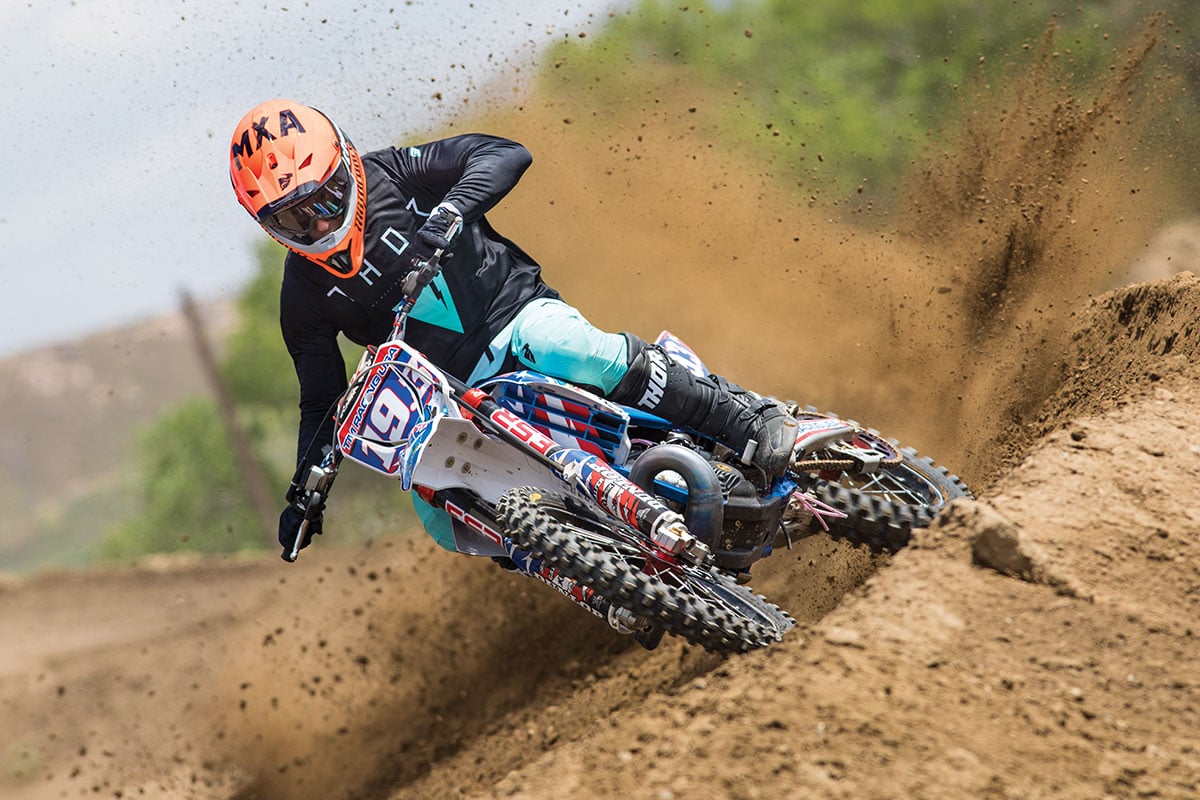
I was grateful that Ralf Schmidt, the CEO of TM USA and builder of this TM 300MX project bike, was there to answer my questions. He explained that the TM 300MX was made for serious riders who don’t want the power of a 450cc four-stroke, don’t like the quick hit and aggressive rev of a 250cc two-stroke, and don’t want to ride the same cookie-cutter bike as the rest of the world but still want to go fast. Because my assignment was a 300cc two-stroke, it was relegated by the FIM and AMA to the 450 class. But, Ralf was kind enough to point out that the TM 300 two-stroke is the most expensive two-stroke you can buy, and thus it most likely would end up in the hands of a bucks-up Vet rider. This helped me narrow my focus on who the target market was for this Italian beauty.
TM has a reputation for producing aggressive, high-rpm engines, which stems from its history in the high-horsepower world of karting, but with the introduction of the 2019 TM 300MX, that limited understanding of TM is no longer valid. The all-new TM 300 two-stroke engine has a smooth and progressive powerband that is cherished among loyal TM supporters. It’s not what the general public thinks of when they think of two-stroke power. It doesn’t hit so hard that you’re constantly feathering the clutch to keep the front end down. Nope! The TM 300MX requires minimal use of the clutch. And because it doesn’t sing with the same pitch as a 125 or 250 smoker, it isn’t allegro; it is adagio (if you’re a fan of Italian opera). The 300MX develops its power and torque in a way that ensures none of it is lost in translation. It is easy to get confused by the steady tempo and feel like the bike is going slow. Yet, what your senses are telling you can’t be true, because you are passing 450 four-strokes going up hills. It’s at this moment, and not until this moment, that you fully begin to understand what riding a 300cc bike is about.
My first-ever experience on a TM 300MX came late last year when I got to do some test sessions on a stock 2019 TM 300MX. Honestly, I didn’t like it. My actual assignment that day was to ride a 2019 Husqvarna TC250, so when Daryl asked me to take the TM 300MX out for a few laps, I was unprepared for the experience. I kept trying to duplicate what I had done on the TC250—and it wasn’t working. I didn’t realize how different the TM 300MX was from the average 250. With seat time and patience, I slowly began to understand how to make the TM300 work. It was an education to say the least.
IN ESSENCE, SECOND GEAR IS DETUNED TO FORCE THE RIDER TO SHIFT UP EARLY IN THE RPM RANGE. IT’S LIKE HAVING A NANNY ON THE BIKE YELLING AT YOU TO SHIFT NOW!
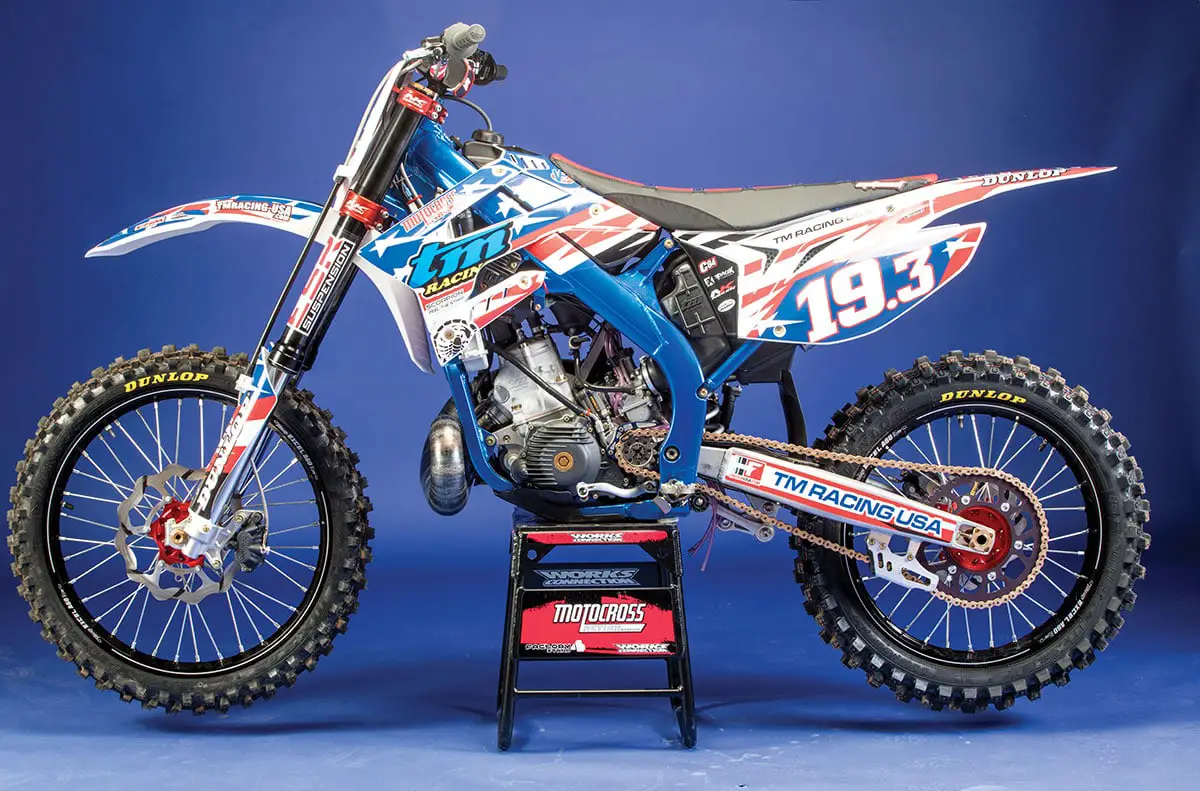
The 2019 TM 300MX I was assigned to test was a project bike—not a stock TM 300MX. And while it had many of the same traits as the stocker, the TM race shop had made modifications to Americanize the TM to make it livelier while maintaining its smooth powerband. There were a few surprises. I felt that the powerband signed off too soon and didn’t get the kind of drive I wanted out of the corners. At our request, Ralf changed the rear sprocket to bring second gear into play sooner. I thought it would respond better to a little more oomph in second gear, but it didn’t. The 2019 TM 300MX was designed to be ridden in third, fourth and fifth gears. Unlike most bikes, the TM 300MX doesn’t like to be ridden in second. Second gear is more like first gear on a different brand. It is only there to give the powerband a little pop just before you shift it into third gear. Don’t believe me? Try one for yourself. There is a gear position sensor that tells the ECU when the bike is in second, and when in second gear the ECU does not allow the engine to rev above 6750 rpm, which is 2000 rpm below peak. It took me some time to get used to the unique powerband. It was unlike anything I had ridden before, except for a kart engine with a governor on it. In essence, second gear is detuned to force the rider to shift up early in the rpm range. It’s like having a nanny on the bike yelling at you to shift now! After some time, I eventually learned to adjust my technique and throttle usage to make the TM 300MX work.
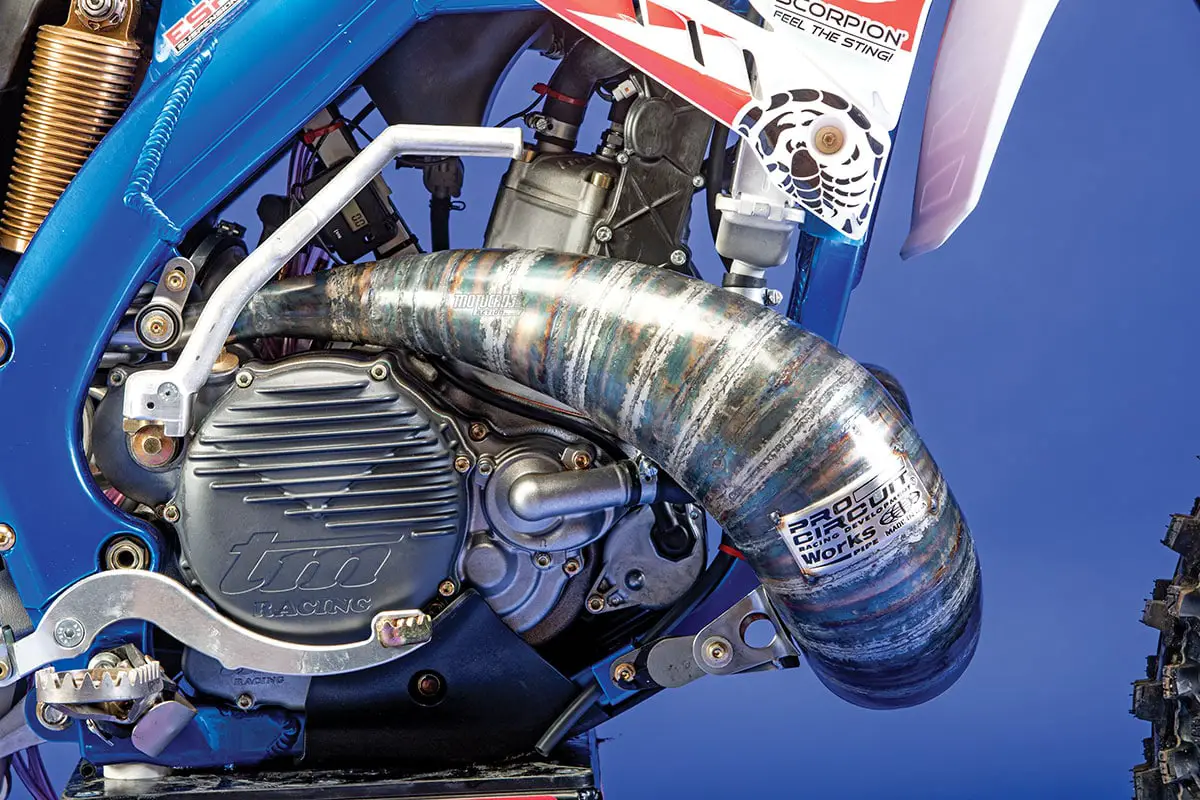
When it came to handling, I didn’t like the TM’s suspension the first time out on the track. I struggled to find confidence entering the corners, and I needed to make some changes, but I didn’t know what those changes should be. Earl Shuler Racing (ESR) built the suspension, and I was the test dummy sent out to find the perfect settings. This was a challenge, because both Earl and I were new to TMs (Ralf was not a lot of help because this bike was so new that even the U.S. distributor didn’t know all of its ins and outs).
The bike wasn’t right, and I didn’t know how to verbalize what I was feeling. I went across the pits and asked Jody how to communicate what I was experiencing on the bike to Ralf and ESR. Jody explained all the variables to me in a way that made sense. He asked a few questions and told me that if the bike was riding high, the suspension wasn’t compressing down in the stroke on the entrance and exit of the corners. In this situation, the bike wouldn’t want to turn. It would push or lift up. That meant that the forks were too stiff and/or that the rear end was too soft. If the front end dove too deeply into its stroke on the entrance of the turns, that would make the front end oversteer. This meant that the forks were too soft and/or the rear end was too high. Jody suggested that I go back out on the track and only focus on the front of the bike in the specific areas where the forks seemed to be the problem. After the quick pep talk, I hopped back on the horse. Rather than try to go fast, I paid attention to the details that Jody had instructed me on. Right away, it all started making sense. I had a mental breakthrough when I was finally able to understand how to explain what I was feeling! I told Ralf and Earl that the current setup rode too high in the stroke and lacked plushness, but, paradoxically, it would also bottom if I hit a bump too hard. After a day of testing, ESR went back to the drawing board to implement this feedback into the valving. They had the re-valved forks back to us the next day.

Right off the bat, the TM 300MX suspension was noticeably better with the updated ESR forks, but it wasn’t perfect. I still felt like the bike was riding too high and wasn’t settling enough coming into corners. Finally, Ralf took a set of forks off the famous all-black TM 300MX project bike that MXA had tested two years ago. Daryl, Ralf, Dennis and Jody assured me that those forks were good. While Ralf was changing the forks from one TM to the next, I hopped on MXA’s 2019 Husqvarna TC250 two-stroke that was set up with soft Vet-style suspension and spun a few laps. I felt like a new man—not because I preferred the TC250 over the TM 300MX, but because I figured out the differences between the two and found what I was searching for. The soft Husky and the tall TM were completely opposite from each other. The Husky squatted too low in the corners, while the TM didn’t squat enough. I wanted something between the two. I was thrilled that I was making progress as a test rider.
I got back on the TM with the black TM’s forks and, just as Ralf had guessed, they felt a lot better. The previous TM project bike forks were softer on top, which helped me in the corners, and they were stiffer from the mid-stroke on, stopping them from bottoming. With forks that worked, I gained confidence and was able to carry some speed into the corners. Earl asked what I wanted, as he had the forks off the bike. I told him I wanted the forks softer initially, which would help them track through the corners better and stiffer from the mid-stroke down. In suspension terms, the damping was more progressive, and I liked it. ESR’s previous setup was the opposite; it was too stiff and then too soft.
I FELT LIKE A NEW MAN—NOT BECAUSE I PREFERRED THE TC250 OVER THE TM 300MX, BUT BECAUSE I FIGURED OUT THE DIFFERENCES BETWEEN THE TWO AND FOUND WHAT I WAS SEARCHING FOR. I WAS THRILLED THAT I WAS MAKING PROGRESS AS A TEST RIDER.
With better guidance in what we were looking for, Earl changed the settings, and we put the original forks back on the bike. Finally, I had the willingness to go fast into the corners and carry my momentum out of them. I still felt that the bike was too high, but this time I was talking about the chassis and not the fork valving. Ralf reached into his bag of tricks and came out with a new rising-rate shock linkage that TM had been developing with a SoCal company named Bzerk. The aftermarket TM shock linkage can lower the rear of the bike 7mm, 14mm or 21mm via changeable inserts. Ralf put the link on, set at 7mm lower, and I went back out on the track. I was blown away. The first thing I said to Ralf when I came back was, “How come we didn’t do that sooner?” Then, as Earl was checking the triple-clamp bolts, he noticed that there were two spacers under the Neken handlebar mounts. I hadn’t noticed the spacers until Earl pointed them out. In truth, the handlebars felt pretty good to me, but I remembered that when we asked Ralf to change the gearing, he balked and Jody told him: “It’s our job to change things. If we’re wrong, we’ll change it back.” So, I decided to try the lower bars. This one little change made the whole project come full circle! After hours and hours of testing, we had found a fork, chassis and handlebar setting that I was happy with. Lower bars, a lower rear end and more progressive suspension settings made all the difference in the world.
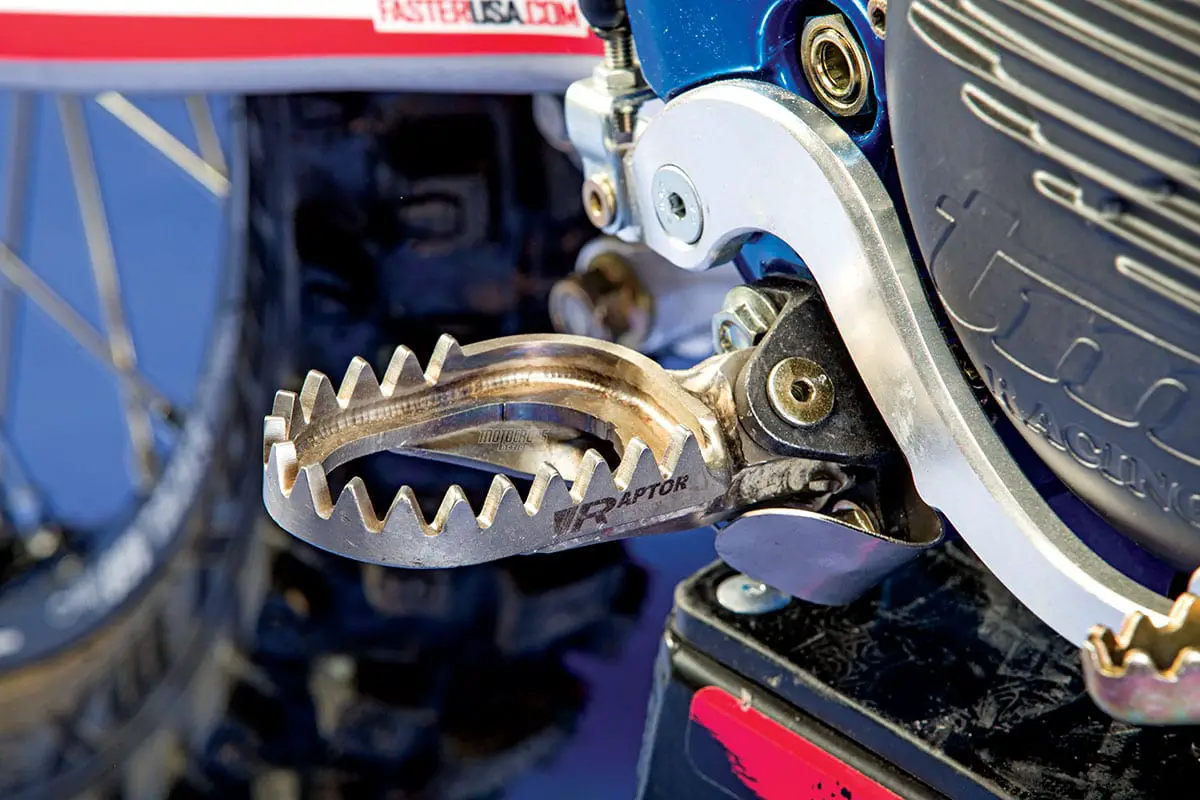
As a young test rider, it was a huge accomplishment for me. The 2019 TM 300MX was a brand-new model for Ralf, and he was able to learn a lot about the peccadillos of the machine. This was ESR Suspension’s first TM build, and they were able to keep up with the rapid changes. And last, this was my first experience as the head test rider. I was responsible for overseeing the testing, fine tuning and eventually finalizing the settings on the 2019 TM 300MX project bike.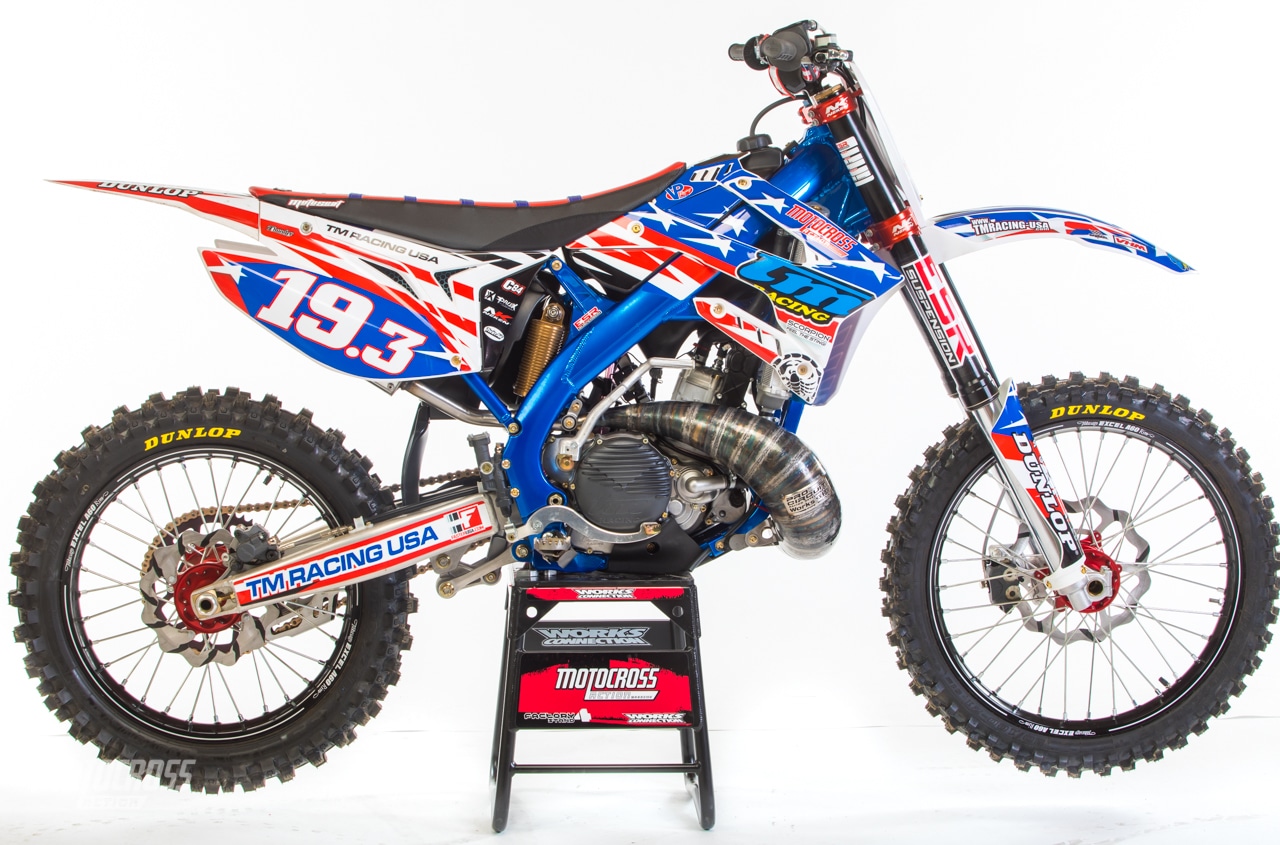
When Ralf builds a project bike, he goes all out. Since TM is a small, boutique brand, it’s able to do things that bigger manufacturers can’t. One of the cool and unique ways that TM makes its customers happy is by offering a service that allows its buyers to custom order their TMs with the exact parts they want. It’s kind of like buying a KTM Factory Edition, only you get to decide what aftermarket parts you want on your new bike. Many of the parts on the project TM 300MX were special, modified OEM TM parts that are available at TM USA. For the parts that TM doesn’t supply, Ralf collaborates with brands close to his Southern California warehouse and race shop.
RALF HAD THE FRAME POWDERCOATED A BRILLIANT BLUE THAT REALLY MADE THE BIKE STAND OUT FAR BEYOND ANY POWDERCOATED FRAME WE HAD SEEN BEFORE. NEKEN TRIPLE CLAMPS WERE ADDED, AND BECAUSE NEKEN DOESN’T MAKE TM-SPECIFIC CLAMPS, RALF USED
NEKEN’S HONDA CLAMPS.

MXA’s project TM 300MX was completely torn down to the frame. Because the 2019 model was completely new, Ralf was excited to tear into the engine and get an inside look at the Italians’ latest technology. To create more top-end, Ralf swapped out the stock cylinder for a factory-modified TM cylinder, replaced the 30cc cylinder head with a slightly higher compression-ratio 29cc version and swapped the stock Vertex Piston for a double-ring ProX piston. When the cases were split, Ralf also polished the gearbox to allow it to shift more easily.
Ralf had the frame powdercoated a brilliant blue that really made the bike stand out far beyond any powdercoated frame we had seen before. Neken triple clamps were added, and because Neken doesn’t make TM-specific clamps, Ralf used Neken’s Honda clamps. Besides a few slight modifications to mount the TM number plate, the clamps slid right on to the TM head tube—bearings and all. To go with the clamps, Ralf used Neken’s unique SFH handlebars. The Neken SFH handlebars are standard 1-1/8-inch (25.4mm) oversize handlebars that taper gradually down to 22mm (7/8 inches) and then, in the last 6 inches, down to 18mm (5/8 inches). In effect, the SFH bars are 5mm smaller in the clutch and throttle sections than a normal handlebar. Neken uses the extra 5mm to fit grips that are 4mm thicker. That is double the thickness of a normal grip. The Raptor titanium footpegs had a really cool metal footpeg cover on the bottom of the peg that Ralf had made. It was open enough to be cleaned out, and it covered enough so that the pegs wouldn’t get plugged up with dirt. These footpeg covers are also available through TM.
MOST AFTERMARKET COMPANIES DON’T ADVERTISE THAT THEY MAKE PRODUCTS FOR TMs, BECAUSE TM IS SUCH A SMALL BRAND THAT THEY DON’T WANT TO WASTE AD SPACE ON SUCH LOW-VOLUME SALES. BUT, MANY COMPANIES DO HAVE TM-SPECIFIC PRODUCTS.
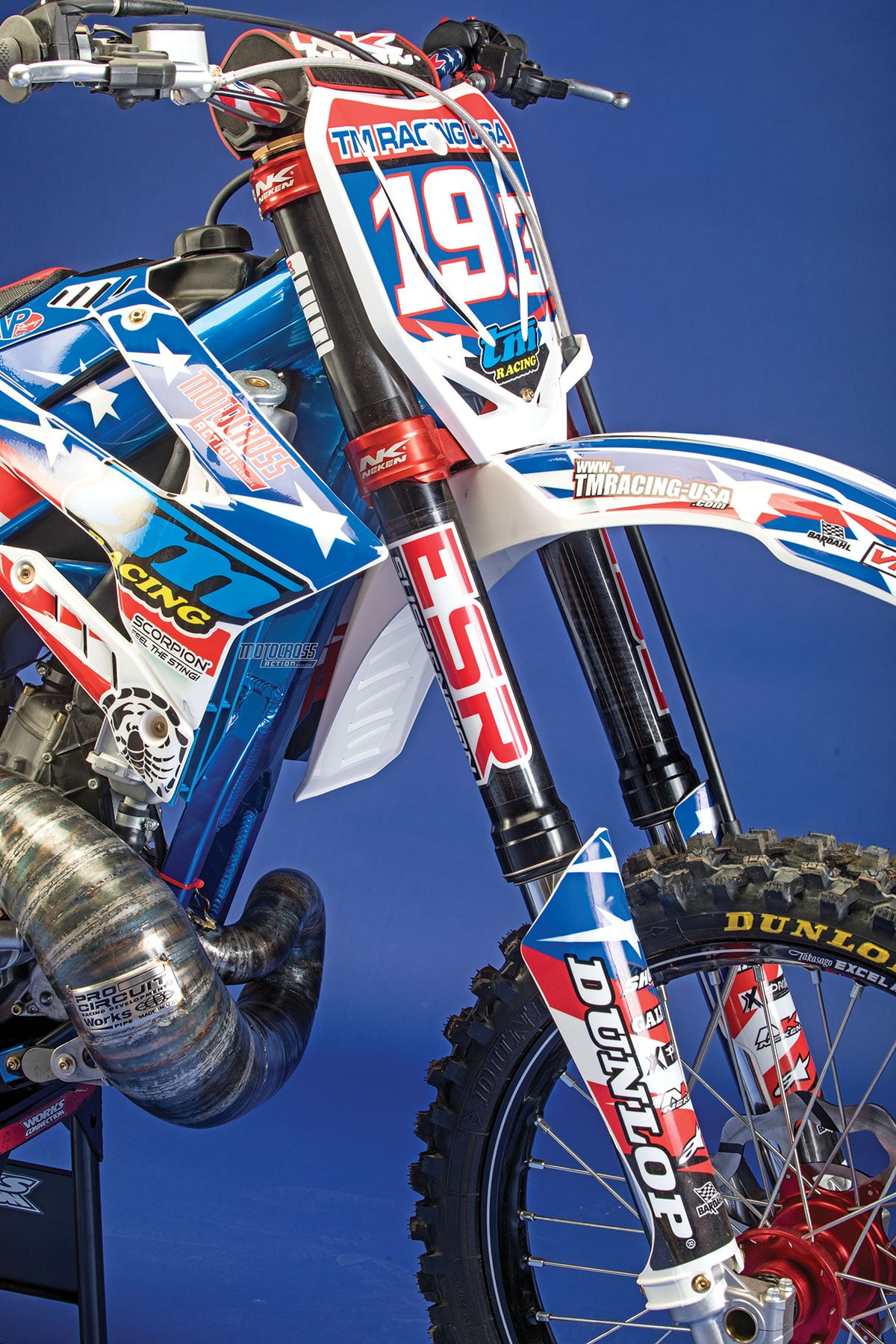
Galfer provided all of the brake parts, including the rotors, pads, brake lines and even the heat shrink that acts as a miniature radiator on the rear brake line. Because TM has had issues in the past, the heat shrink ensures the rear brake doesn’t overheat. The clutch cover, front and rear brakes, the rear brake master cylinder and ignition cover were all Cerakoted to give them a factory look and make them more durable. Because TM only produces wheels with blue rims and silver hubs, Ralf ordered Black Excel A60 rims and red FasterUSA hubs.
Most aftermarket companies don’t advertise that they make products for TMs, because TM is such a small brand (only producing 1200 bikes a year) that they don’t want to waste ad space on such low-volume sales. But, many companies do have TM-specific products. If you call FasterUSA to order TM wheels, they will send you a KTM front wheel and a Honda rear wheel that will fit right on. Just make sure to order a Honda rear sprocket and brake rotor and not the TM sprocket and hub. We ran a 13/50 gear combo, and ProX provided the chain and sprockets.

To give the TM 300MX the extra spunk we were looking for, we played with the jetting. The slide got moved from 6.5 to 7. The pilot went from 45 to 42. The needle was a N1EH, and we put it on the second clip from the top. We used the stock Twin Air filter. Motoseat made a seat cover that was reinforced on the sides to prevent wear. We also disconnected the map switch because we didn’t need it on the MX track. Ralf also switched out the stock KYB upper fork stanchions for the 2017’s black outer fork stanchions for aesthetics.

All of the special parts on MXA’s project TM 300MX are available to the public. Ralf is a no-nonsense Dutchman—and there’s no reason for Ralf to build a bike if people can’t buy the parts. This is a bike that people will want to duplicate. For more information, go to www.tmracing-usa.com.




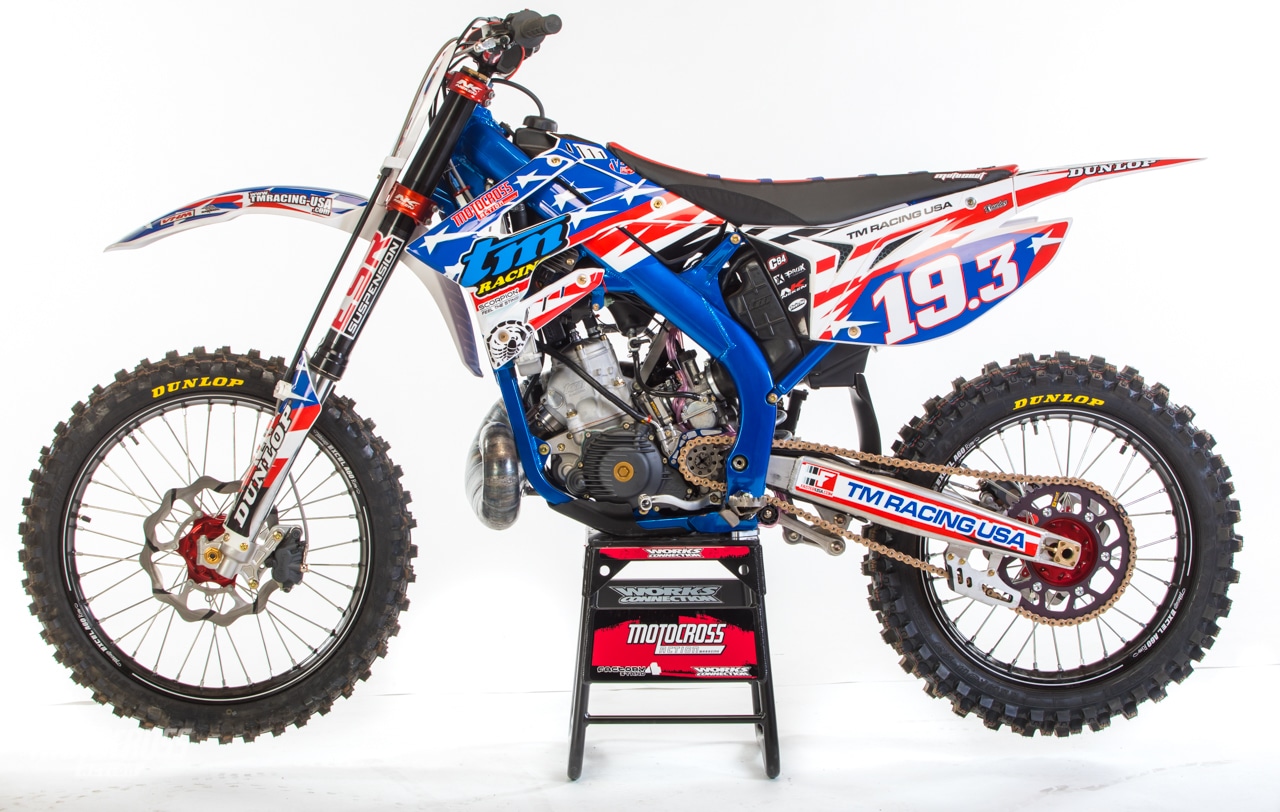
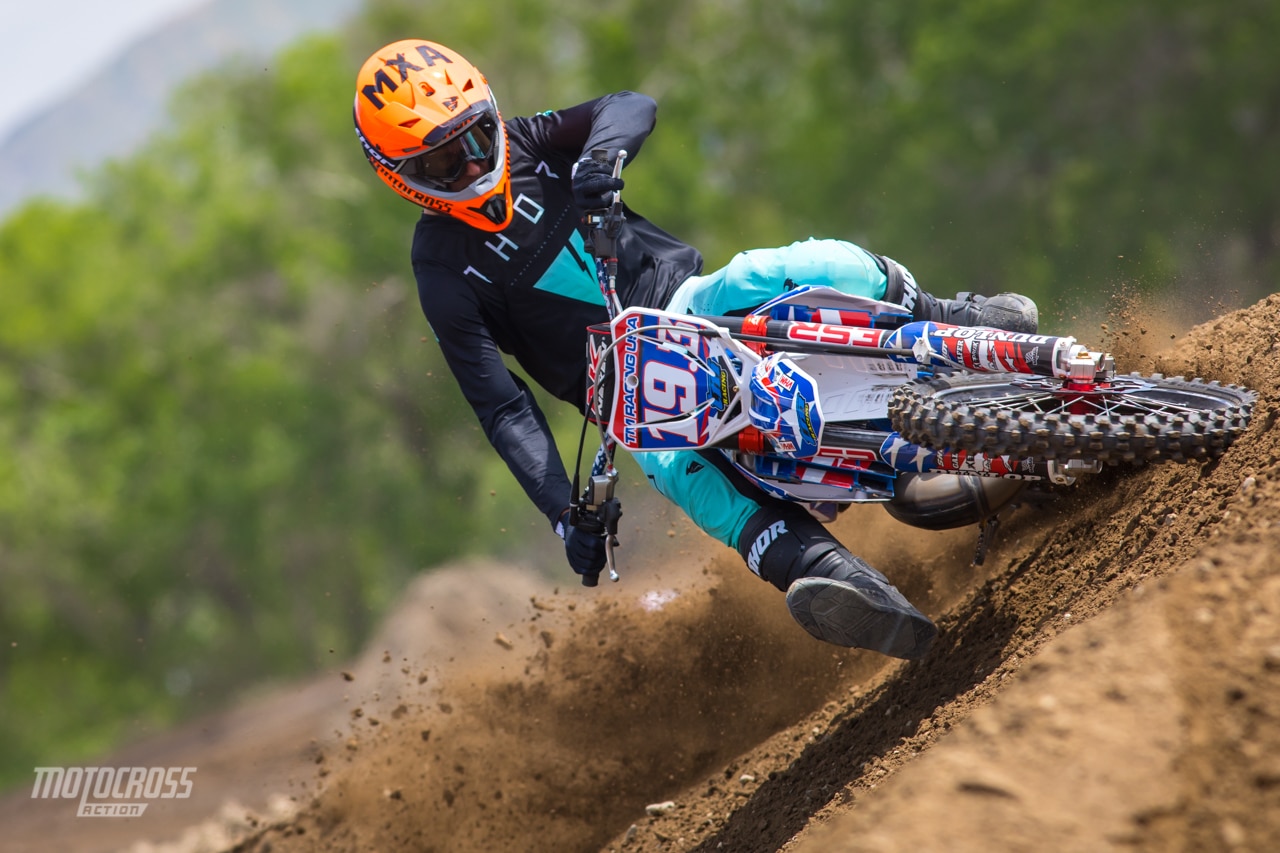






Comments are closed.